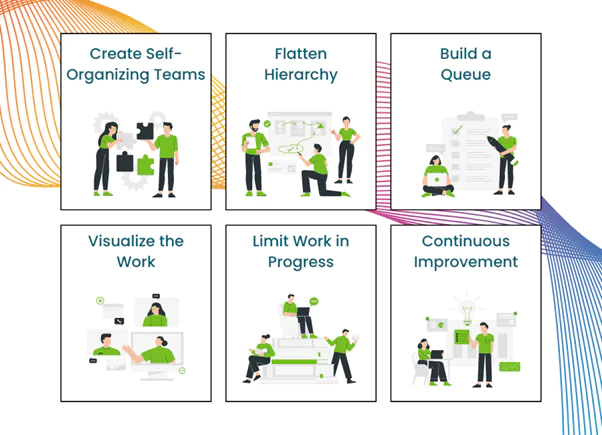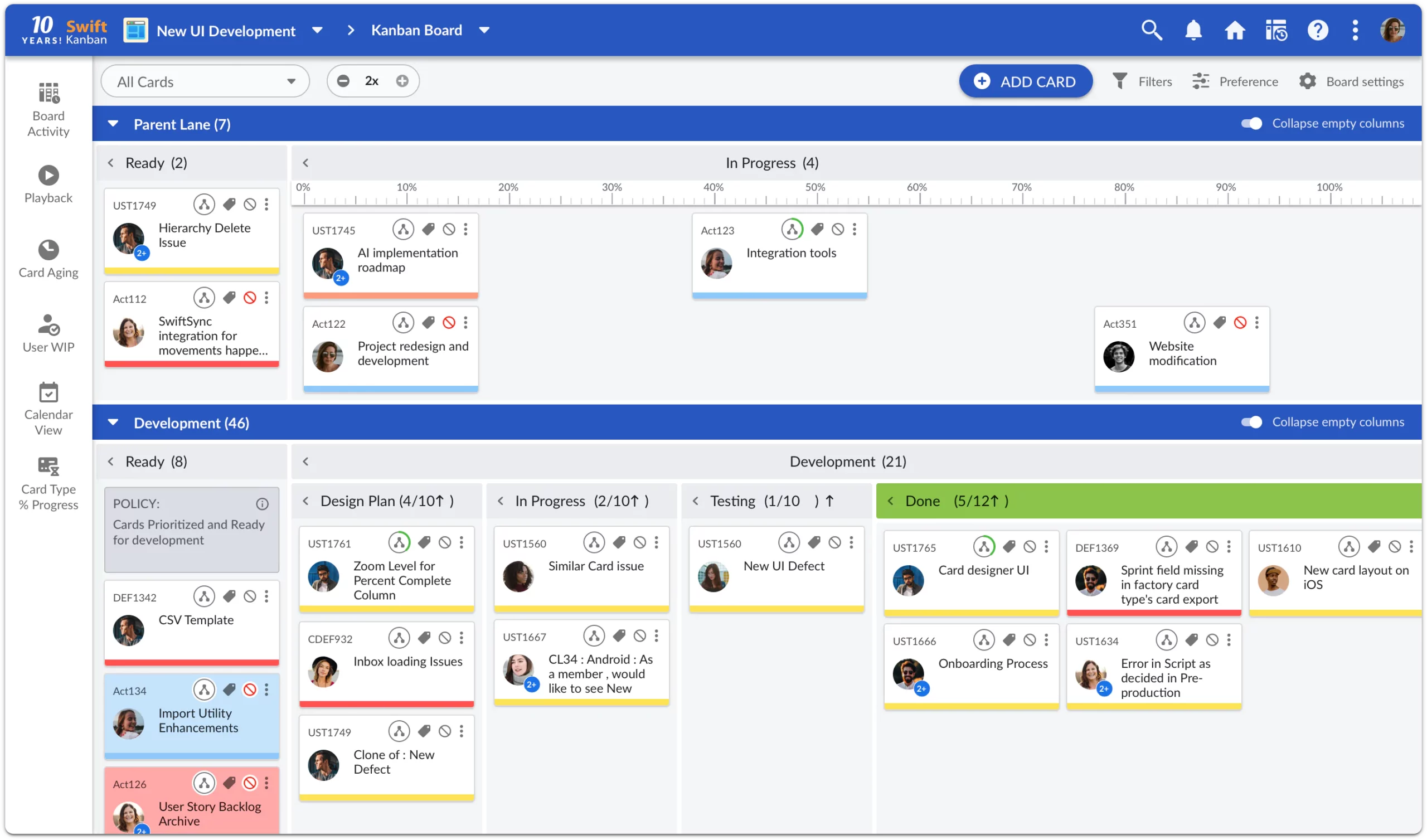With technological innovations, market conditions, and customer demands evolving faster than ever, becoming and remaining a high-performing organization is a tremendous challenge.
To be sustainable and efficient, more and more organizations are choosing to adopt an Agile mindset. According to the 5th Annual State of Agile Marketing Report:
43% of marketers surveyed use Agile in their work through practices like daily standups, sprint planning, backlogs, Kanban boards, etc. Share on X
By managing operations and resources in a flexible, responsive way that focuses on maximizing business value, agility at scale can transform organizations. It empowers them to adapt and respond quickly to market changes.
It’s fundamental for any organization that wants to be successful to understand what widespread business agility means in both theory and practice and what it looks like. Let’s discover what value can be achieved through applying the Agile principles and values in the business units of your organization.
What is Business Agility?
Business agility is a management approach that empowers organizations to develop, succeed, and prosper by responding quickly to changes and opportunities with innovative and streamlined processes.
Agile originated in IT, where organizations use it to break big projects into smaller chunks, ensuring faster and more sustainable software delivery. Slowly, it gained popularity outside of IT, particularly in marketing where the same principles have been adapted to fit the needs of that field.
Now, there’s a trend of Agile spreading to adjacent departments such as sales, finance, and HR. The 5th State of Agile Marketing Report reveals that 33% of sales teams use Agile practices, followed by 20% in finance, and 16% in HR. This is driven by a key fact uncovered in the same report: Agile teams overwhelmingly prefer working with other Agile teams.
In other words, the more Agile the organization, the merrier the teams within it.
Agility empowers individuals, teams, and companies to innovate, experiment, satisfy customers’ changing needs, and adapt to market shifts. As a result, organizations can stay competitive and relevant by streamlining their processes, emphasizing frequent delivery using fewer resources, being adaptive, and focusing on the value they provide.
Agility as a Competitive Advantage
Unlike traditional organizations, truly Agile businesses can keep up with the fast pace of market change and even thrive in conditions that might completely derail their competitors.
Agility is one of the few ways to handle the higher-than-ever levels of complexity in the business world while also innovating at the speed of customer expectations. In addition, being Agile is a path to great benefits that every business wants – lower costs, faster production, higher ROI, added value, customer satisfaction, and opportunities for innovation.
How to Have a Successful Business Agility Transformation?
No matter the industry you’re in, Agile is likely to become a bigger part of what you do in the near future. So, to get yourself prepared, here are six things you can do now to start embracing the Agile mindset.
1. Create Self-Organizing Teams
The core of business agility lies in empowered self-organizing teams. They are given the freedom to make tactical decisions, take chances, and accept responsibility with a value-driven approach, allowing upper management to focus on business strategy instead of micromanagement.
Agile teams can either be functional or cross-functional. Cross-functional teams are formed by people with different expertise working toward a common goal. On the other hand, functional teams are formed around a particular skill set, like finance, sales, HR, etc.
Functional teams also have their place in the Agile organization. They can act as shared services teams that receive requests from other cross-functional and functional teams in the organization. Businesses employ shared services teams to concentrate and streamline the operations of multiple units. These teams can assist sales, marketing, finance, legal, and other departments.
As a result, Agile teams are able to build collaborative, quick, and high-quality products. By applying Agile practices and working collaboratively, they can improve workflow processes, which helps the organization generate more value.
You may want to start small and experiment with one cross-functional team before trying to transform all departments. It mainly depends on your organization’s level of agility. No matter how you decide to proceed, implementing Agile well means your adaptability and speed in terms of providing value to clients will improve.
2. Flatten the Hierarchy
Corporations such as Spotify, Amazon, and Google have already experimented with and adopted the Agile approach. This has led to them famously transforming their hierarchical organization into flat ones. This process is also known as delayering. Instead of structuring the organization as a hierarchical pyramid with management at the top, flat organizations treat the organization as an organism where teams and leaders work alongside each other towards common goals.
A horizontal or flat organizational structure means there are few or no management levels between executives and employees.
A flat structure has numerous significant advantages, including making the organization more flexible to change due to the elimination of layers of control, as well as raising the level of responsibility held by employees.
3. Build a Queue
Your queue (also known as a “backlog”) is a strictly prioritized list of all the work that you and your team plan to do within the next three months. As a result, you’re able to define the top priorities and force yourself to decline unplanned work requests that don’t align with the current workload.
4. Visualize the Work
Regardless of the framework, visualization is a crucial part of Agile and managing work. This way everyone is in the loop and knows what to do and when it should be done.
By visualizing the workflow, teams are able to gain perspective into how they’re truly spending their time, expose bottlenecks in their process, reduce the quantity of work they do, and place greater focus on quality and value. One of the most common visualization tools among Agile teams is the Kanban board which allows organizations to prioritize and limit their work in progress by committing to a certain amount of work.
5. Limit Work in Progress
Work in progress (WIP) limits are designed to act as guardrails to discourage us from starting more simultaneous projects than we can reasonably finish. The main idea is to stop committing to new work and focus on what we currently have going on, finish it and then pull in something new.
Marketers are prone to accepting every piece of work that comes their way. Unfortunately, this leads to far too many projects in progress at the same time. As a result, more time is spent switching between them and the projects take longer to finish.
Setting a healthy limit on how much work you can actually tackle is critical to avoiding this. When you do, you’ll notice that productivity, value, and customer and stakeholder satisfaction will increase.
6. Establish a culture of continuous improvement
Develop a culture that is always looking for ways to improve and innovate. A business agility transformation involves strong dedication to new market developments and satisfying the expectations of customers by constantly adapting and improving.
Make sure you’re able to measure the progress as you go with your Agile journey so you can focus on data-driven decisions that move your business forward.
Business Agility is Waiting For You
Business agility transformation is complex and requires commitment. However, with shared efforts towards mindset and culture shift, organizations will be able to reap the benefits of a thriving Agile environment across all of their departments.
We expect business agility to spread to even more business units and take over as the standard management approach in the future. Don’t let your organization fall behind. All signs point to business agility becoming the new standard way of working. Regardless of the market conditions, risks, and opportunities, by implementing the Agile practices across your organization you’re likely to stay ahead of the competition and thrive.








